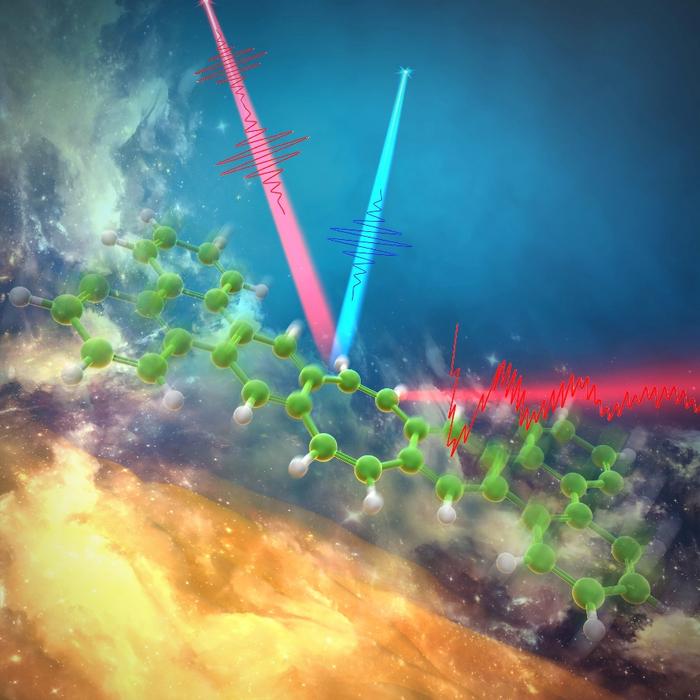In a remarkable breakthrough that promises to enhance our understanding of ultrafast molecular dynamics, a team of scientists led by Hikaru Kuramochi has achieved the first real-time visualization of the intricate process by which excited-state aromaticity emerges within mere hundreds of femtoseconds. This pioneering research, which captures the fleeting structural transformations that lead a molecule to shift from a bent to a planar configuration, opens new avenues for the development of advanced photoactive materials. By employing state-of-the-art ultrafast electronic and vibrational spectroscopies, the investigators shed light on the mechanisms that govern these ultrafast processes at the molecular level.
The concept of aromaticity is a cornerstone of organic chemistry, describing the unique stability of cyclic compounds where electron delocalization occurs. Traditionally, discussions about aromaticity have focused primarily on molecules in their ground states. However, recent explorations into “excited-state” aromaticity suggest that this phenomenon plays a critical role in influencing structural changes and chemical reactivity in photoexcited molecules. While prior studies have investigated the dynamics of excited-state aromaticity, most have done so within a “near-equilibrium” framework. This focus has left substantial gaps in our understanding of the exact timing and interaction between excited-state aromaticity and the resulting structural changes.
The investigators’ approach is rooted in a cutting-edge combination of femtosecond transient absorption spectroscopy and time-resolved impulsive stimulated Raman spectroscopy (TR-ISRS). This advanced technique allows researchers to monitor vibrational frequencies across a range from terahertz to 3000 cm⁻¹ with femtosecond resolution. In their groundbreaking study, the team explored a newly synthesized cyclooctatetraene (COT)-based molecule named TP-FLAP, specifically designed to exhibit distinctive “flapping” motion. By exciting TP-FLAP with a femtosecond laser pulse, they were able to probe its dynamic vibrational signature precisely, giving them a clear picture of how the molecule’s central COT ring transitioned towards a planar form.
The findings revealed that an initial sub-picosecond electronic relaxation, occurring around 590 femtoseconds, endowed the bent molecule with aromatic character. Following this initial transformation, the molecule underwent planarization on a picosecond timescale, as evidenced by a distinctive frequency shift in the vibrations of the carbon-carbon bonds within the ring. Remarkably, by employing isotope labeling with ¹³C, the scientists were able to ascertain the specific vibrational modes associated with the bending-to-planar transition, providing a direct link between excited-state aromaticity and the observed structural rearrangements.
Through their meticulous measurements and calculations, the team established that aromaticity not only emerges quickly but also becomes more pronounced as the molecule shifts to its planar configuration. The revelations surrounding the dynamics and influence of excited-state aromaticity deepen our comprehension of fundamental light-driven processes. Importantly, these insights carry significant implications for designing high-performance photoactive materials, including advanced sensors, tunable fluorescence probes, and innovative photoresponsive adhesives.
The culmination of this research marks a paradigm shift in how chemists can approach the design of materials that harness the power of aromaticity. Notably, the TR-ISRS methodology not only elucidates the role of vibrational modes in driving structural changes but also sets the stage for exploring various systems characterized by excited-state (anti)aromaticity and intricate conformational modifications. As scientists expand upon this pioneering work, the potential applications for such a technique extend beyond the current scope, promising a revolutionary impact on material science and chemistry.
This research, conducted at the Institute for Molecular Science and supported by various prestigious institutions, including the Japan Society for the Promotion of Science, highlights the collaborative nature of modern scientific inquiry. Harnessing advanced techniques and computational tools, the team’s investigation underscores the ongoing quest to bridge the gap between theory and experimental observation in the study of chemical reactions.
The implications of directly observing excited-state aromaticity and its cascading effects on molecular structure cannot be overstated. As researchers strive to design molecules with specific functionalities, understanding such ultrafast processes will be instrumental in guiding innovations in molecular engineering and synthetic chemistry. The strategy of leveraging molecular dynamics to inform material design presents a transformative outlook for the creation of future technologies.
In essence, this study not only deepens our theoretical understanding but also serves as a compelling call to action within the scientific community. As techniques grow ever more sophisticated, the pursuit of real-time observation of molecular changes stands to redefine how chemists approach the synthesis and application of neutral and charged species in photoactive systems. The expanded toolkit afforded by TR-ISRS could become a cornerstone of research in various fields, catalyzing breakthroughs that harness the intricacies of molecular behavior.
As these developments unfold, the excitement surrounding their potential applications continues to rise. From smart adhesives that respond to environmental stimuli to sensors that offer rapid, accurate readings under varying conditions, the results of this study usher in a new wave of possibilities. Researchers are positioned to capitalize on these findings, propelling their work toward the next generation of advanced materials designed from the ground up based on principles revealed through the study of excited-state dynamics.
In conclusion, the implications of this groundbreaking work extend well beyond the realm of fundamental chemistry. By revealing the rapid dynamics that link excited-state aromaticity with structural transformations, this research not only enriches the academic understanding of these processes but also paves the way for significant, practical advancements across a range of scientific industries. As we stride into a future where design meets dynamic functionality, the potential for innovation remains limitless and waiting to be explored.
Subject of Research: Excited-state aromaticity and molecular dynamics
Article Title: Excited-State Aromatization Drives Nonequilibrium Planarization Dynamics
News Publication Date: 9-Mar-2025
Web References: https://doi.org/10.1021/jacs.4c18623
References: Available via the journal “Journal of the American Chemical Society”
Image Credits: Copyright Kuramochi group/ created by Science Graphics. Co., Ltd.
Keywords
: Ultrafast spectroscopy, excited-state dynamics, aromaticity, molecular structure, TR-ISRS, cyclooctatetraene, photoactive materials, chemical reactivity.
Tags: advancements in organic chemistry researchchemical reactivity in photoexcited moleculeselectron delocalization in cyclic compoundsexcited-state aromaticityground state vs excited state aromaticitymechanisms of molecular reactivityphotoactive materials developmentreal-time molecular visualizationstructural transformations in moleculesultrafast electronic spectroscopyultrafast molecular dynamicsvibrational spectroscopies in chemistry



![Nickel-Catalyzed Regioselective Hydrogen Metallation Cyclization of Alkynylcyclobutanones Enables Synthesis of Bicyclo[2.1.1]hexanes](https://bioengineer.org/wp-content/uploads/2025/11/Nickel-Catalyzed-Regioselective-Hydrogen-Metallation-Cyclization-of-Alkynylcyclobutanones-Enables-Synthesis-of-120x86.jpeg)

